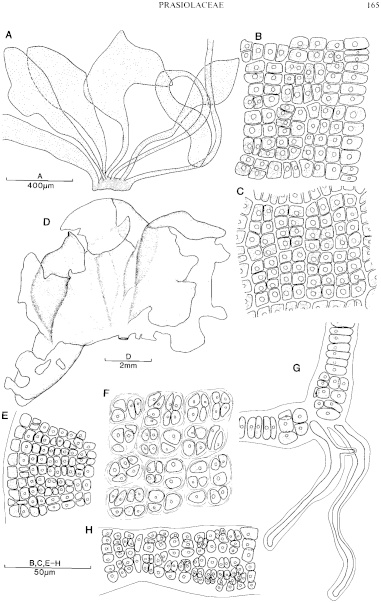|
|
|
|
|
|||||||||||
|
Electronic Flora of South Australia Species Fact Sheet
Phylum Chlorophyta – Order Prasiolales
Selected citations: Chapman 1956: 431. Gain 1912: 178. Knebel 1936: 13, figs 2–10. Newton 1931: 79. Wille 1902: 209, pl. 3 figs 1–20, p1. 4.
Synonym
P. antarctica Kützing. Chapman 1956: 431, fig. 82. Svedelius 1900: 289, fig. 2b,c, pl. 16, figs 4,5.
Thallus (Fig. 52D) medium to dark brownish-green, on rock well above high tide level, individual thalli single, 2–5 (–20) mm across or high, usually partly vesicular or cupulate and crisped, occasionally expanding as a relatively flat sheet, attached by a few rhizoids or slight holdfast, or free, not stipitate. Growth marginal and diffuse, margin smooth to irregular, with ill-defined blocks of cells. Cells (Fig. 52E,F) isodiametric to elongate, 3.5–7 (–10) µm across or long in surface view, often in weakly defined groups of four or more; chloroplast somewhat stellate with a central pyrenoid.
Reproduction: Reproduction not recorded (?).
Type from Scotland?; in BM (ex K)?
Distribution: N. Europe, Antarctic and subantarctic.
In southern Australia, known from south-east Tasmania only: Lady Bay, Southport, Tas., on rocks in bird roosting area, 3–4 m above high tide in spray zone (Curtis, 6.xii.1958; HO 57886; ADU, A53835 and Womersley & Parsons, 28.x.1982; ADU, A53837-"Marine Algae of southern Australia" No. 231). Recherche Bay, Tas., supralittoral on rocks in bird roosting area (Womersley, 28.x.1982; ADU, A53836).
Taxonomic notes: These Tasmanian collections agree well in form and cell arrangement with P. crispa, which is generally accepted to include the Antarctic P. antarctica. It differs in form and lack of a stipitate base from P. stipitata, and usually consists of small, crisped plants densely aggregated on rocks where birds roost, subject to salt spray only under storm conditions. The Curtis collection, however, shows that flat sheets to 2 cm long and as much across can develop.
References:
CHAPMAN, V.J. (1956). The marine algae of New Zealand. Part I. Myxophyceae and Chlorophyceae. J. Linn. Soc. Bot. 55 (360), 333–501, Plates 24–50.
GAIN, L. (1912). La flore algologique des régions Antarctiques et subantarctiques. In Deuxième Exped. Antarct. Francaise, 1908–1910. pp. 1–128, Plates 1–8.
KNEBEL, G. (1936). Monographie der Algenreihe der Prasiolales, insbesondere von Prasiola crispa. Hedwigia 75, 1–120, 3 maps.
NEWTON, L. (1931). A handbook of the British seaweeds. (British Museum: London.)
SVEDELIUS, N. (1900). Algen aus den Landern der Magellansstrasse and West Patagonien. Svenska Exp. till Magellansländerna, 3(8), 283–316, Plates 16–18.
WILLE, N. (1902). Mittheilungen über einige von C.E. Borchgrevink auf dem antarktischen Festlande gesammelte Pflanzen. III. Antartktische Algen. Nytt Mag. Naturvidensk. 40, 209–221, Plates 3, 4.
The Marine Benthic Flora of Southern Australia Part I complete list of references.
Publication:
Womersley, H.B.S. (31 May, 1984)
The Marine Benthic Flora of Southern Australia
Part I
©Board of the Botanic Gardens and State Herbarium, Government of South Australia
Illustration in Womersley Part I, 1984: FIG. 52 D–F.

Figure 52 enlarge
Fig. 52. A–C. Prasiola stipitata. A. Holdfast with several stipitate blades (ADU, A20486). B. Cells near margin (ADU, A22607). C. Cells within margin of thallus (ADU, A22607). D–F. Prasiola crispa (ADU, A53837). D. Habit, with slight basal attachment. E. Cells near margin. F. Cells in older part of thallus. G.H. Rosenvingiella polyrhiza (ADU, A5769). G. Largely uniseriate filament with rhizoids. H. Older multiseriate part of thallus.

|
Email Contact: State Herbarium of South Australia |

|